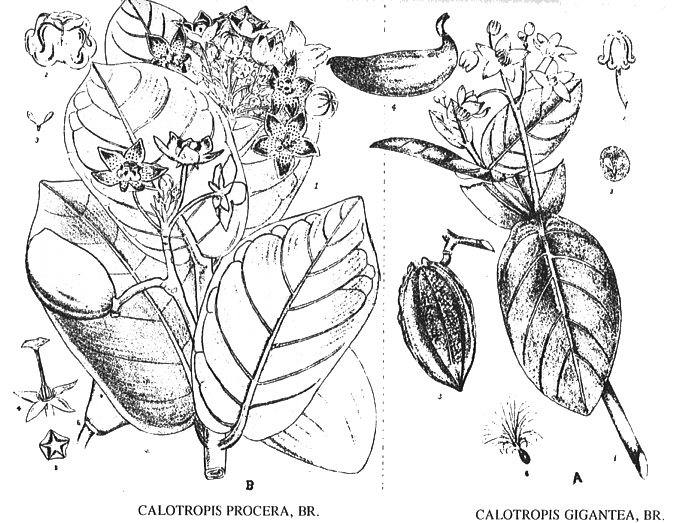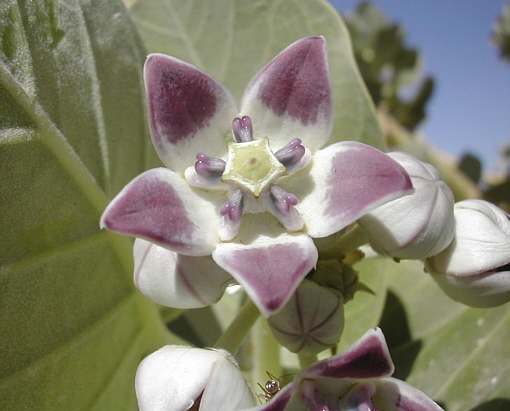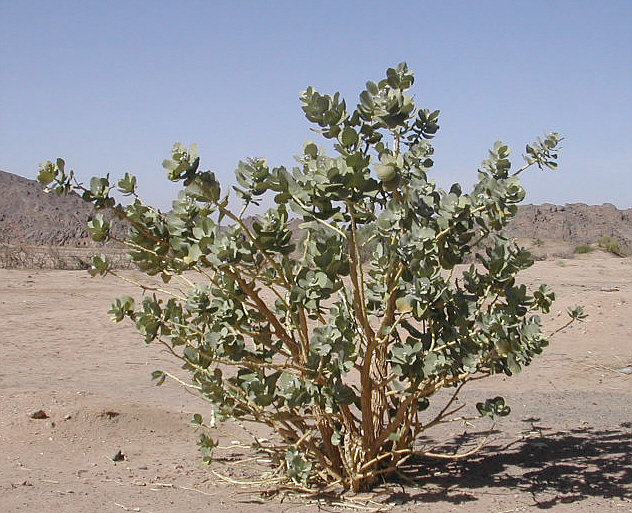

Zitierweise / cite as:
Carakasaṃhitā: Ausgewählte Texte aus der Carakasaṃhitā / übersetzt und erläutert von Alois Payer <1944 - >. -- Anhang A: Pflanzenbeschreibungen. -- Calotropis procera (Ait.) R. Br. -- Fassung vom 2007-05-10. -- URL: http://www.payer.de/ayurveda/pflanzen/calotropis_procera.htm
Erstmals publiziert: 2007-03-19
Überarbeitungen: 2007-05-10 [Ergänzungen]
Anlass: Lehrveranstaltung SS 2007
©opyright: Dieser Text steht der Allgemeinheit zur Verfügung. Eine Verwertung in Publikationen, die über übliche Zitate hinausgeht, bedarf der ausdrücklichen Genehmigung des Verfassers
Dieser Text ist Teil der Abteilung Sanskrit von Tüpfli's Global Village Library
WARNUNG: dies ist der Versuch einer
Übersetzung und Interpretation eines altindischen Textes. Es ist keine
medizinische Anleitung. Vor dem Gebrauch aller hier genannten Heilmittel wird
darum ausdrücklich gewarnt. Nur ein erfahrener, gut ausgebildeter ayurvedischer
Arzt kann Verschreibungen und Behandlungen machen!
Falls Sie die diakritischen Zeichen nicht dargestellt bekommen, installieren Sie eine Schrift mit Diakritika wie z.B. Tahoma.
Verwendete und zitierte Werke siehe: http://www.payer.de/ayurveda/caraka0001.htm

Abb.: Calotropis procera und Calotropis gigantea
[Bildquelle: Kirtikar-Basu, ©1918]

Abb.: Calotropis procera (Aiton) Dryand.
[Bildquelle: Wikipedia]

Abb.: Calotropis procera (Aiton) Dryand.
[Bildquelle: Wikipedia]
Drury:
"Calotropis procera (R. Br.) Do. Description.—Shrub, 6-10 feet; leaves ovate or oval, cordate at the base; segments of the corolla spreading, revolute at the margin; leaflets of the staminal corona equalling the gynostegium; umbels peduncled; follicles obovoid, downy; flowers pale purple. Fl. March—April.—R. Br. in Hort. Kew, ii 78.—C. Wallichii, Wight Contrib. 53.—C. Hamiltonii, do.—— Deccan. Guzerat. Patna. Hindostan.
Medical Uses.—This species differs from the former in the segments of the corolla not being reflexed. It is a widely distributed plant, very abundant in the Bellary district, but quite unknown in the southern provinces._ In uses, the two species are probably similar in every respect Five grains of the bark of the root of this species mixed with very minute doses of arsenic, is internally administered in the form of a pill in leprosy with the best effect— (Wight.) The bark of the root is diaphoretic and expectorant It is used m European practice as a substitute for ipecacuanha, both as an emetic and cure for dysentery. The fresh juice is used as a rubefacient in rheumatism and chest-diseases, and the leaves as a cure for Guinea-worm.—(Powell's Punj. Products.) In the Peshawur valley the juice is employed in the preparation of catgut, and for raising blisters and discussing chronic tumours.—Stewart's Punj. Plants. Pharm. of India."
[Quelle: Drury, Heber <1819 - 1872>: The useful plants of India : with notices of their chief value in commerce, medicine, and the arts. -- 2d ed. with additions and corrections. London : Allen, 1873. -- xvi, 512 p. ; 22 cm. -- s.v.]
Dutt:
"CALOTROPIS GIGANTEA AND PROCERA, R. Br. Syn. Asclepias gigantea, Roxb.
Sans. arka, alarka.
Vern. Ākanda, Beng. Mādār, Hind.
Calotropis procera and C. gigantea, both pass by the native name of mādār. C. procera the smaller of the two, prefers the drier climate of the Deccan, the Upper Provinces of Bengal, the Punjab and Scinde; C. gigantea, lower Bengal, the Madras and Malayan Peninsulas, and Ceylon. Sanskrit writers mention two varieties founded upon the colour of the flowers, namely, white, called alarka, and red, called arka. The milky juice, flowers, root-bark and leaves are all used in medicine. The root-bark is said to promote the secretions and to be useful in skin diseases, enlargements of the abdominal viscera, intestinal worms, cough, ascites, anasarca, etc. The milky juice is regarded as a drastic purgative and caustic and is generally used as such in combination with the milky juice of Euphorbia neriifolia. The flowers are considered digestive, stomachic, tonic and useful in cough, asthma, catarrh and loss of appetite.
The leaves mixed with rock salt are roasted within closed vessels, so that the fumes may not escape. The ashes thus produced are given with whey in ascites and enlargements of the abdominal viscera.
The following inhalation is prescribed for cough. Soak the powdered root-bark of arka in its own milky juice and dry. Bougies are prepared with this powder and their fumes inhaled. The root-bark, reduced to a paste with sour congee, is applied to elephantiasis of the legs and scrotum. The milky juices of Calotropis gigantea and Euphorbia neriifolia are made into tents with the powdered wood of Berberis asiatica, for introduction into sinuses and fistula in ano. The milky juice is applied to carious teeth for relief of pain.
Arka taila. Take of prepared sesamum oil, four seers, juice of arka leaves, sixteen seers, and turmeric reduced to a paste, one seer ; boil them together in the usual way. This oil is said to be useful in eczema, and other eruptive skin diseases. Sometimes orpiment is substituted for turmeric is this preparation."
[Quelle: Dutt, Uday Chand: The materia medica of the Hindus / Uday Chand Dutt. With a glossary of Indian plants by George King. -- 2. ed. with additions and alterations / by Binod Lall Sen & Ashutosh Sen. -- Calcutta, 1900. - XVIII, 356 S. -- S. 196 - 198.]